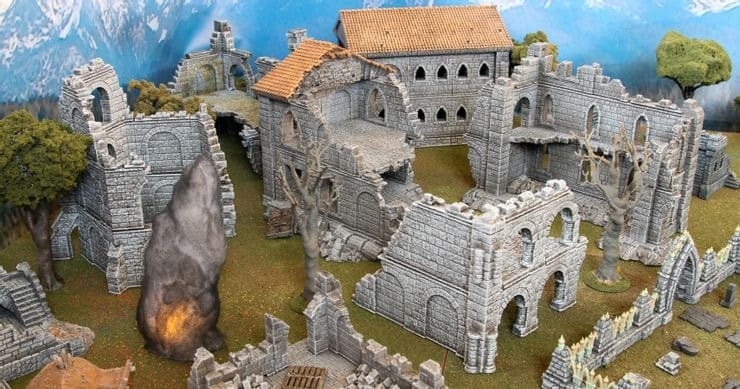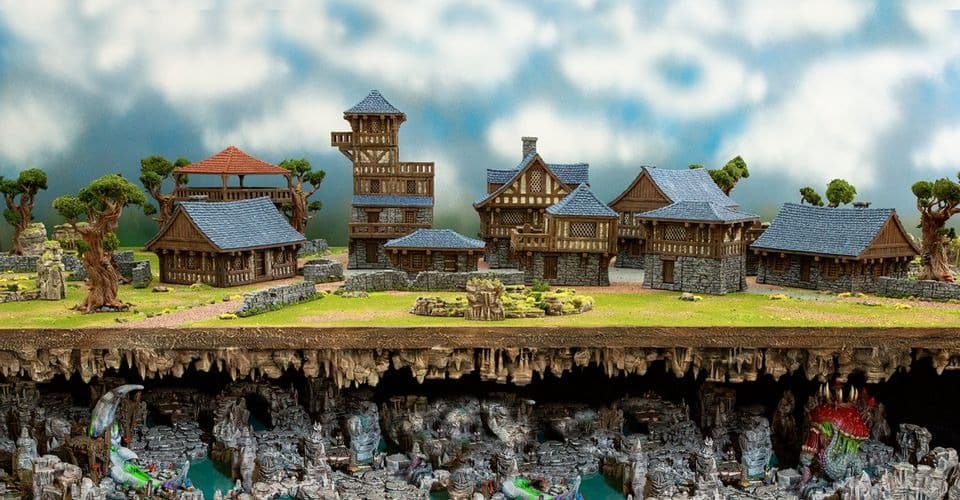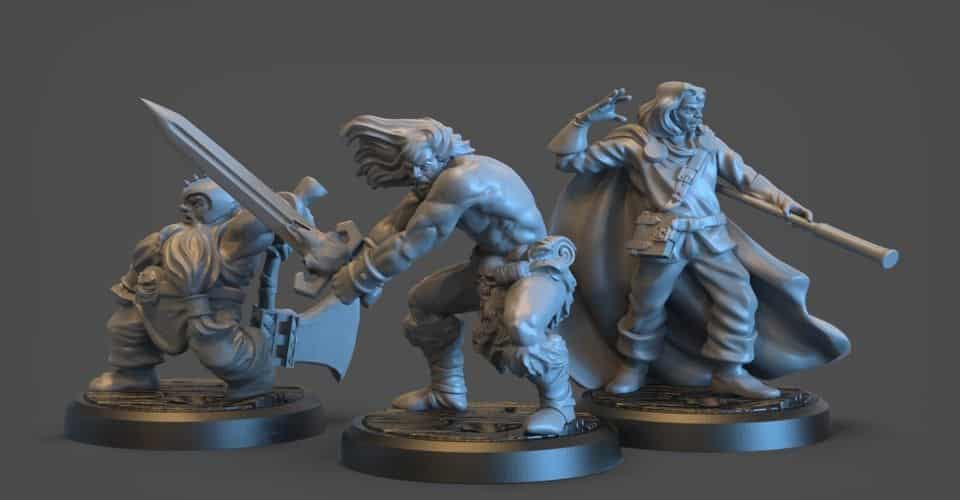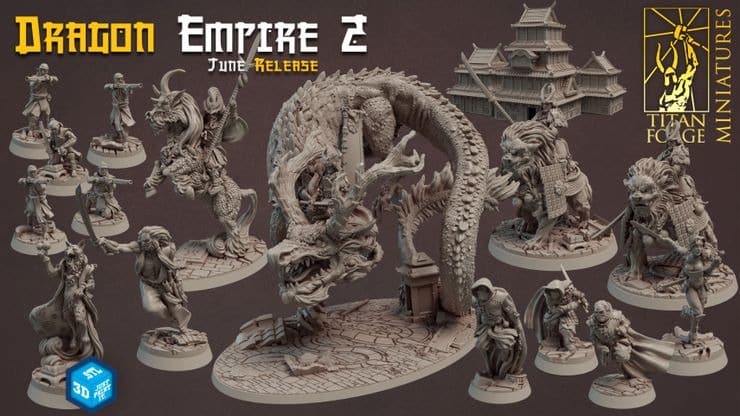You may have heard of 3D printing, but did you know it can enhance your tabletop games? Indeed, some people have put it into practice and upgrade their battlefields and towns of D&D, Warhammer, and other tabletop games.
Thanks to a community of talented designers and hobbyists, there is a hidden treasure trove of scenery, terrain, tools, and miniatures you probably know little about. While this article can’t dive too deep into a singular area, keep an eye on the site for more articles on 3D printing for tabletop soon, we will take a birds-eye view of what it can do for you.
How does it work?
Before we can print, we need a 3D model. These can be designed using a 3D graphics tool such as Blender or 3D Studio Max, but don’t worry, for tabletop gamers there are already a wealth of models available thanks to talented artists who are willing to share.
Once the 3D model has been obtained, it will require some pre-processing and preparation for printing using a bit of software called a slicer. Most models will print fine, but sometimes supports may need to be added to ensure that the fiddly bits print properly. Supports are nothing more than scaffolding that will allow parts or overhangs to print where there are air gaps below. Thankfully a lot of files contain both the raw print file as well as print-ready file.
Next up is slicing, imagine taking a very fine blade to a miniature and slicing it up into thin layers. This is how a 3D printer works, it takes the processed model and slices it up into many layers. This information is then saved into a file and interpreted by the printer at which point it will work layer by layer to reproduce the data. 3D printing is nothing more than 2D printing on top of each other.
Slicer Software
- Prusa Slicer
- Cura
- Chitubox (SLA Only)
3D Printed Terrain
Have you ever sat opposite your foe as you line up your Warhammer armies to do battle and thought, “I wish I had some buildings to make the battlefield look more interesting?” Fret no more, for today we look at how 3D printing terrain can improve your games.
What to print?
Sit down before starting and ask yourself what you want to print and why? Do you have a specific need? Is it a one-off? Are you a GM or a wargamer? What size do I need? All these questions will help you decide what you print.
For wargamers, the choice may seem obvious. Gothic looking structures for sci-fi wargaming, as an example. Single print models always look amazing, but if used too much you and your players could get bored with them fairly quickly. You may also find that after a few games you (and your opponent) know the model inside and out, and the advantageous shooting spot now leaves you wide open for elimination.
This is where the power of 3D printing comes in. Whereas buying an injection molded kit gives you a great looking centerpiece, 3D printing not only provides this but also lets you work with small run kits that would not ordinarily be possible as well as models that are impossible to manufacture unless they were 3D printed. Add to that the reusable multi-part models that can be rebuilt (think Lego) into different structures giving you near-infinite combinations. Don’t forget the scatter terrain.
There is a good selection available that you can print cheaply such as boxes, and crates, and drums, and in a variety of different styles. There is nothing stopping you from mixing and matching models from different designers as well. After all, why should every town or world look the same? Allowing for this localization is not possible using off the shelf kits without heavy modification.
Models To Print
There are both commercially available and free models to print. Be mindful of the free models, 3D printing suffers from piracy with paid-for models often appearing on 3D printing forums. When this happens it is the artist that suffers directly, as they are often the ones selling the model, and if their revenues drop then they may no choice but to stop designing new models. Support individual designers by buying models direct from them or by joining their Patreon.
With that said, there are many free models you can print. Sites like Thingiverse, YouMagine, and Prusa Printers give designers an outlet for their models. There are typically no costs involved unless you use a print service (where they print it for you) but many do let you tip the designer. If the designer has commercially available models or a Patreon, this will usually be stated in their about page; use this if you can as they will typically receive a greater share of the donation.
You can also find commercially available models to print at Printable Scenery and Fat Dragon Games. Both specialize in dungeon tiles but have a range of buildings and miniatures available. If you are unsure if these will fit your game they have free sample packs you can download and print.
https://www.instagram.com/p/B8xQHd-nt8F/?utm_source=ig_embed
Some of Our Favorite Terrain Models
- DragonLock Outdoor Terrain
- DragonLock Village
- Printable Scenery’s Scatter Terrain
- Printable Scenery’s Fantasy Ruin
- Printable Scenery’s Post-Apocalyptic
- Rampage Castle
- Terrain4Print
- Warhammer Scenery on Thingiverse
- Wargaming Terrain on Thingiverse
- OpenLock on Thingiverse
- 3D Rune on Patreon
- Aether Studios
3D Printed Miniatures
We’ll stick with 28mm as the default. As for which printers to use? SLA is the preferred choice as you will get better results, but if you don’t have this option FDM can be used. Be prepared for lots of failed prints and slow print times as you tweak and optimize your printer. Also don’t expect the same level of quality as official minis.
There are three main methods of acquiring your miniatures, free, Patreon supported, and off the shelf. We should also note that the same can be said for 3D printed terrain.
Free Models
Free models are available through the likes of Thingiverse. A quick search for “28mm miniature” will give you a list to start exploring. Other search terms such as “D&D miniature” give equally impressive lists. The grandmaster of 3D printed minis has to be Miguel Zavala. He offers a large collection of D&D miniatures for free. Some of his models are available on Thingiverse, but he has had to move his efforts to Shapeways. You can still get his work for free, but you now also have the option of a professionally printed 3D miniature. He also has a Patreon where supporters can download all his models, over 1000, from one place.
Patreon Supported
When it comes to Patreon supported you have lots of choices, with a variety of studios producing art worthy of note. Titan Forge is a hybrid company, providing some physical products through retail stores and their own webshop, as well as a range of minis available through Patreon. Each month they have a theme, with June 2020 being an oriental themed set called Dragon Empire 2. The models are professionally designed and come with raw print files as well as pre-supported print files which should make like easier. The great thing about supporting the work of creators through Patreon is that you are directly supporting creators, enabling them to spend more time creating such wonderful minis. There are too many talented designers to list in totality, but check the list below for some of our favorites.
Off The Shelf
In recent times we have seen a move by tabletop studios to move some of their paper products to digital formats. Core rule books, army lists are obvious candidates, but print-at-home maps, scenery, and buildings are now a mainstay of most RPG games. There are some pioneers such as Mōphiüs Entertainment that have released off the shelf 3D models to print at home. The Fallout Miniatures game models can be found here, and at the time of writing there is a variety of scenery and vehicles available. Hopefully, we’ll see more manufacturers releasing files including miniatures. For the moment the best way to buy individual models off the shelf is to search platforms such as My Mini Factory and Shapeways. Both specialize in high-quality 3D prints, but you can also download or buy files as well. A prime example of this is the Artisan Guild. Often you will find the files listed have previously been available for a lower price in a previous month on Patreon. Sometimes it pays to support an artist if you like their style!
DIY
Earlier, we noted that there were three main methods to acquiring print files, but there is a mystery fourth option. Imagine if you could create custom miniatures for each of your players, that matched not only their descriptions but also the equipment they carry. Well, yes you can. If you are a talented artist/sculptor then you may fancy trying out blender (https://www.blender.org/) or ZBrush (https://pixologic.com/features/about-zbrush.php), both powerful and capable at producing 3D models to print. For the rest of us, however, we can turn to services such as HeroForge that allow us to design our own miniatures using their web app. It is easy to use and after completion, you can buy the print file. As a GM, you probably wouldn’t want to do this for every character your players come across, but for player characters and important figures such as the final boss, it may be worth the money.
Favorite Artists & Prints
- Miguel Zavala
- Titan Forge
- Duncan Shadow Louca
- Michael Mordor
- Archvillain Games
- Filippo Giovannini
- HeroForge
- Anvl
A Final Word on 3D Printing for Tabletop
As we bring this series we hope you have seen the potential that 3D printing can bring to your game. With it all said and done, 3D printing is nothing but a tool and should be treated as such. It is not a replacement, but it should complement the craft you already have. If you enjoy making things with your hands, continue to do so, but use the 3D printer where it makes sense. Print bits rather than full buildings, tile-able floors that can be used reused in different formations, and miniatures that can’t be found elsewhere. Continue to support your local games store, if there is enough interest maybe you could encourage them to stock 3D printing supplies in addition to their gaming range?
And most of all, have fun!





